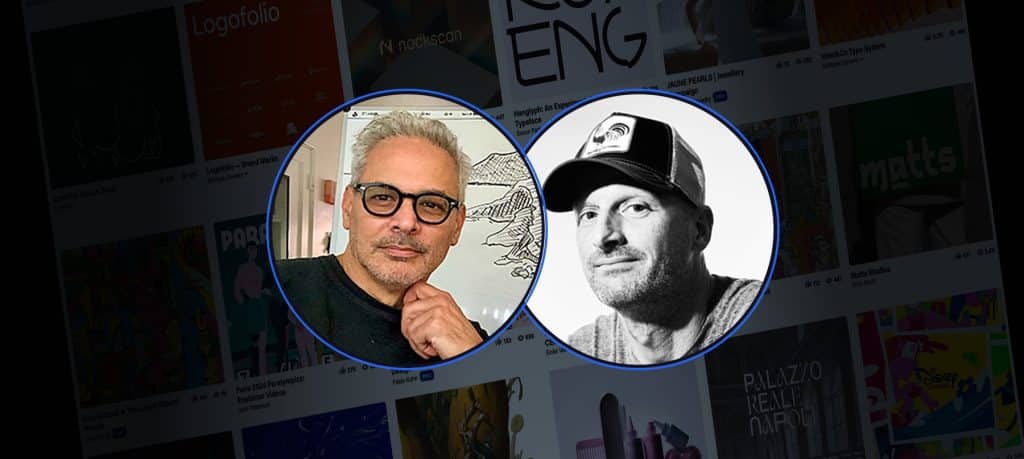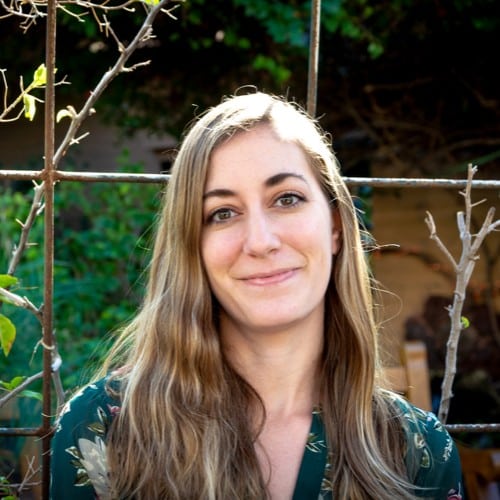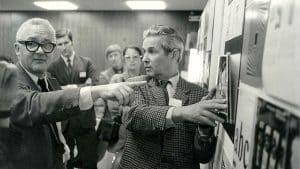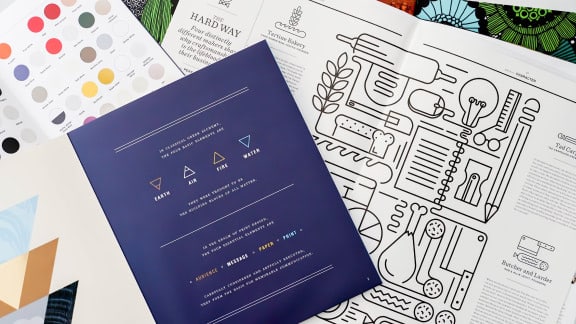The Ultimate Creative Portfolio Guide

Recently Sessions College President Gordon interviewed two professional designers in a live event for registered attendees, tackling some of these big questions head-on.
Sessions Instructor Andrew Shalat is an accomplished designer and long-time educator who has shared his experience working with clients like Macworld with thousands of students. As Executive Vice President of Creative at LA design firm Cold Open, Gardner DeFranceaux has built and lead teams of designers, illustrators, and photographers in creating projects for film, theater, television, and streaming.
In this article, we’ll answer questions like:
- What you should I include in my portfolio?
- What makes a portfolio stand out?
- What do employers look for in a portfolio?
- How many projects should be in a portfolio?
- How Sessions is helping students to think creatively and build their own portfolios
What is a Portfolio?
A portfolio is a curated representation of who you are and what you can do creatively. In Italian, portafoglio literally translates to wallet—the thing we always carry with us. In the same way, a portfolio is the currency you carry as a designer.
Portfolios have undergone a lot of change over time. Gardner explained that when he started out, the portfolio was a physical thing that a new hire would bring into an office to present to employers. Today, most of the people that he works with, himself included, work from home and so portfolios are generally online and either hosted on a website or in a PDF.
Since portfolios are often viewed by employers without the designer in the room to explain it, working concepts should be easy to understand without too much explanation. “If you need to explain your work, maybe it’s missing a mark,” as Gardner said. He added that there may be times where more explanation or a ‘vouching for your work’ may be needed when presenting a concept to a client. However, these incidents should be fewer and your portfolio is not where you should need to be in the room to explain, or you’ve likely already lost the bid for the position.
The main point to keep in mind with today’s prevalence for digital portfolios, is that the work should stand for itself and show your creative thinking.
What Employers Look for in a Portfolio
“How do you get the point across and explain it without actually being in the room?” Andrew asked. The answer, he said, is that a portfolio should be simple and easy to navigate. As Gardner explained, “It should stand for itself, it shouldn’t have too many bells and whistles….I had one person send me something that was so involved I became frustrated going through it because I couldn’t get from one end to the other.”
When assembling your portfolio, keep in mind these three points: what is this product, what does it do, and how did I arrive at it? For example, consider showcasing how the piece lives in the world through mockups and then discuss why this piece in this scenario solves the client’s design problem. Think of it like a key in a map: spell out the colors, font, and other technical points in a box somewhere to the side of the project. In this way, “[Employers] can rely on the fact that [the designer] did make a decision about the type and color” and that it wasn’t just a “happy accident” as Andrew explained.
When curating your portfolio, think quality over quantity. Your work should be the strongest that you have: from content, to composition, to color and type—it should all stand strong in every piece.
You should also always be prepared to vouch for your work if called in for an interview. “Prepare yourself. Go through your book on your own and talk about each piece and why you did it or what it is. You should have some answer for each piece you’ve done. You should have it in your head because this is something you’ve lived with. We have to do this in the industry when we walk clients through our work,” Gardner explained.
As a new designer, it’s important not to take feedback or rejection personally because it’s not uncommon to have a client reject or dislike your work. Instead, these moments can be a learning experience where you can ask clients: “Why did we miss the mark and how did we miss it?”
Andrew added that it’s common among young designers to become emotionally attached to their designs. “Your work has to serve something other than how you feel about it…you do your job and go off to the next one. It’s not romantic, but it’s professional.” Each project should be completed to solve a client’s design or creative problem, rather than to simply be the designer’s creative vision. “Try to solve what the project needs and know that they’ve hired you for a reason.”
Additionally, it’s important to be honest about who you are and your work. As Gardner explains, “You don’t want to get in a position that’s over your head because then you’re going to be stressed out all the time, and stress brings on very bad creativity. If you’re stressed, your work is going to suck.”
How to Get Noticed
The portfolio is a living document that changes over time as you progress through your career and with digital platforms, the ability to be fluid is more achievable than ever. Don’t hesitate to curate it one way and then change it a few days later to better match a different audience that you’re catering to. Consider who your audience is and tailor the portfolio so that it clearly shows your ability to produce what that company is looking for—and that you’re able to bring in some ideas that they haven’t already thought of themselves.
As Gardner explained, “Some of your solutions should be out of the box and completely wack, weird.”
Employers are sifting through lots of applicants and portfolios, so whatever you can do to stand apart from everyone else will help capture attention. Don’t be afraid to be bold and push boundaries—show not only your artistic creativity but your ability to creatively solve a problem in a way that others may not think to do so.
How to Get Started as a Student or Recent Grad
The most difficult period in a designer or creative’s careers is at the beginning. There’s a catch-22 when it comes to being a student or recent grad and trying to showcase “experience.” In this sense, employers understand a portfolio won’t be perfect but instead, they’re looking for evidence strong creative thinking.
Consider making up your own projects that are centered around your own personal interests or what you’re passionate about. Don’t fill your portfolio with the kind of work you hate doing if you don’t want to be stuck doing it.
Think of the portfolio as a story or a movie: there should be a piece that really pulls someone in or a big opening, a story about who you are as a creative, and then and a strong end. “Not everything has to be the biggest thing in the world or the best but they should show different aspects of what you can bring to the table,” as Andrew explained.
Gardner added that as an employer viewing a student or recent grad’s work, “I’m not expecting to see this amazing, huge, finished portfolio. What I want to see is great thinking, and great ideas. I want to see great design and I want to see some storytelling. I want to know a little about that person.” It may not be the most professional work of your career, but it should let the viewer in on your creative process.
Gardner also advised to consider including some hand-done work. With so much done digitally and now with AI technology jockeying for creative attention, having a piece here or there drawn or crafted by hand and scanned in really stands out.
This is your chance to think outside the box, be bold, and make a statement about who you are and the kind of work you can and want to do.
How Sessions College Helps Students Build a Portfolio
“We’re teaching students to be professional,” Andrew says. “You train as a designer to see the world a certain way…why does this work and this doesn’t work? It’s a daily thing.”
It’s not always enough simply to learn to use design tools like Photoshop or Premier Pro—there’s a thought process and critical thinking that creates a true creative professional and the team creating the classes at Sessions is well aware of this. That’s why we’ve offer classes like Design Deconstruction, Visual Storytelling and Storyboarding, and Creative Exploration.
In preparing new artists for working in the real world, we also understand the importance of having working experience and a portfolio. Students at every program level—from Certificate, to Associate Degree, to Bachelor’s, all come away with individual pieces that they can showcase in their portfolio. Degree students will work directly with instructor to compile and curate their own works, and students that graduate from the bachelor’s programs at Sessions will do so with a professionally published body of work on Behance.
Study Your Craft With Us
With various program levels available, students are able to build out their own education journey at Sessions College.
-
- Begin with a 24-credit Undergraduate Certificate—learn the fundamentals of your major and begin building a body of work along the way.
- Advance to a 72-credit Associate Degree—build advanced skills, learn to market yourself and work within a creative business, and finish with a portfolio.
- Complete your journey with the 120-credit Bachelor’s Degree—create projects unique to you and what you’re passionate about with instructors and then celebrate your graduation with a professionally published portfolio of works.
If you’re interested in learning more you can request more information here or call our Admissions team at 480-212-1704, option 1.

Jessica is the Product Marketing Manager at Sessions College, ensuring a consistent message across all marketing touchpoints, using branding and lifecycle marketing email campaigns, onboarding communications, retention strategies, and engagement initiatives. Read more articles by Jessica.
ENROLL IN AN ONLINE PROGRAM AT SESSIONS COLLEGE:





